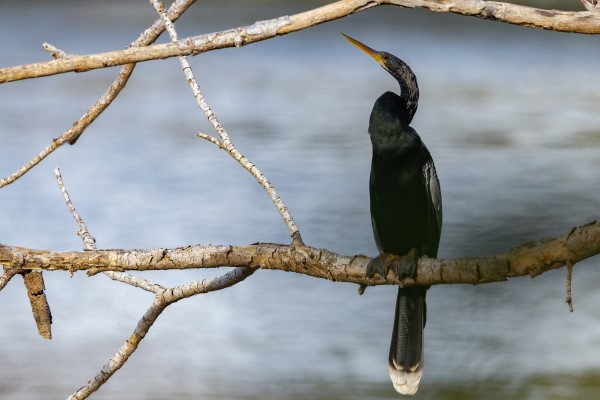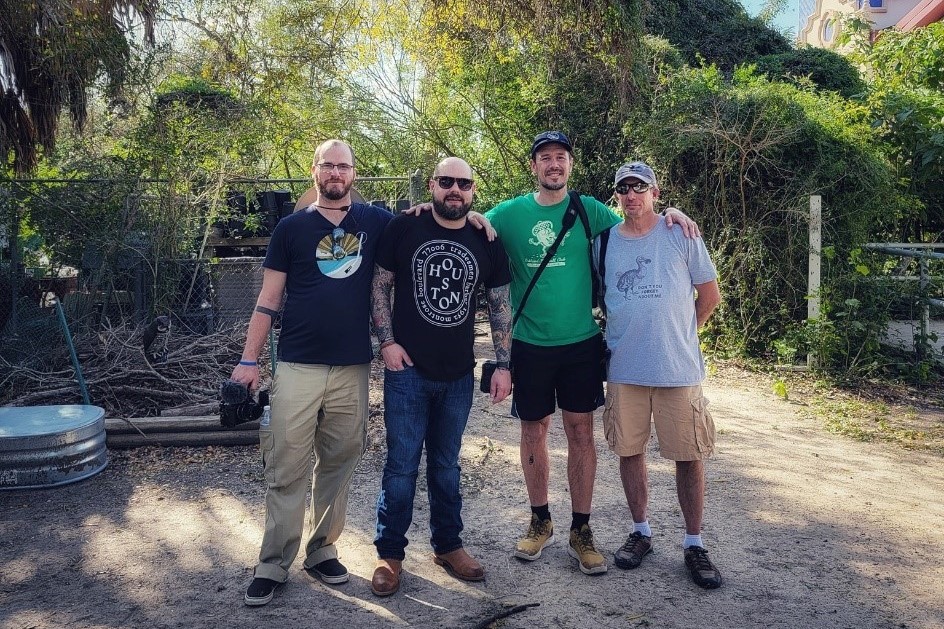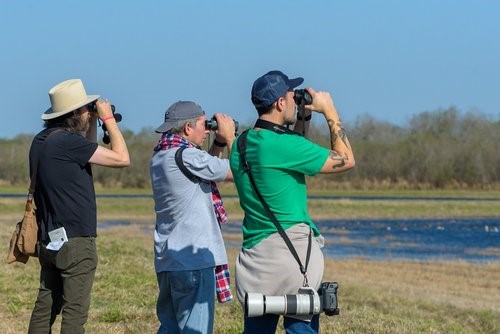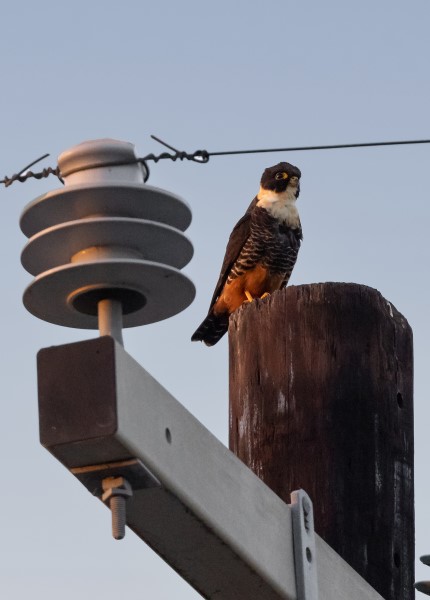The blog about the stray woodpecker in a cemetery was such a smash hit, that the clever folks in our PR dept. proposed taking it to the next level. My mind raced with possible sites to visit that would fall under the general theme of ‘Cool birds in strange places’, but invariably the best group of sites to visit was my favorite part of our beloved Lone Star State, the Lower Rio Grande Valley (i.e., Hidalgo and Cameron counties) just north of the Rio Grande and Mexico.

I love this region because I spent so many years in Latin America doing fieldwork, and many of the species in this region bordering Mexico are indeed Neotropical (dwelling in the New World [sub]tropics). During the 6 hour drive on the way down, trip producer Mike Rathke and I discussed various topics, mostly revolving around birds. One of the topics that came up was ‘bird goals’ for this trip. Mike mentioned he had never been to this region, so I told him we should try and get him 10 lifers (the first time to see a bird in your life). Personally, I had seen over 100 species in Cameron county already, so was a bona-fide member of the Cameron county century club for birding (when you see at least 100 species in a given Texas county). For Hidalgo county I only had 84 species, so was hoping to close in the gap and add that county to my list of century clubs.
In a former life during younger years I was a professional bird/nature guide. ‘Scouting’, a verb used by guides when they are exploring a new region, was borrowed from the fearless Scout soldiers, and during times of manifest destiny and long cattle drives. The Scouts would ride ahead of the clan and find a safe area to camp overnight. Similarly, birding Scouts will explore an area before bringing tourists there, to make sure it is productive (for seeing lots of birds), as well as safe. It is for this noble profession for which we named our daughter, Scout.
Although most of my Scouting/Guiding work took place in the Peruvian Amazon, the principles remain the same regardless of where you guide. With this in mind, I created our itinerary for this fun project to make sure we would see LOTS of birds, try our luck at nailing some rare birds, and above all – observe Cool birds in strange places. We had a crowd representing such a vast array of experience and interest levels with birding:

© 2022 Jay Dryden / jaydryden.com / Used with permission, all rights reserved.
- Mike was the other birder on the trip as well as the museum’s photographer.
- One of Houston’s top reporters, the Houston Chronicle’s Arts and Entertainment writer Andrew Dansby enjoys birding, but perhaps less extreme than Mike and I. Here is an article he wrote about our trip.
- Johnny Hemberger, the museum’s YouTube Channel producer, who made a great video chronicling part of the trip.
- Houston Chronicle talented photographer Jay Dryden, who was also Dansby’s partner-in-crime.
- Craig Hlavaty, the museum’s Press Director, who is a big fan of the Astros and all things Pop culture. Here is a podcast about the trip he did with Mike.
Knowing full well that some of the people in this crowd were completely new to birding with luke-warm interest on a good day, I wanted to make sure the first day made a big splash! We all met at the South Padre Island Convention Center – why at a Convention Center?? STRANGE! The reason we congregated at this Convention Center was because it dons a nice boardwalk spanning over a quarter of a mile among coastal marsh, bay and wetlands. Here the birds were big, beautiful, and easy to see without binoculars – ideal for those newly dipped into birding. One of the most memorable parts of this site was Dansby asked me if he could have possibly seen an Osprey nearby, just before entering the parking lot? Before I could emphatically reply yes, we literally walked up on an Osprey perched close by for all to see. I think my response to that was asking Dansby to query me about giraffes or Harpy eagles in hopes we’d have similar luck? Although the Osprey incident was perhaps the highlight of that site, in total we saw 25 species.
While we only saw a measly 7 species at the next site, Oliveira Park, sometimes it really is all about quality over quantity. The quality species at this site were three species of loud and IN-YOUR-FACE Amazon parrots. We were lucky enough to score a pair of the rarer species at this particular site, the Red-lored parrot, along with about 50 White-crowned parrots and a couple hundred Red-crowned parrots. What an amazing and LOUD show they put on! Amongst a park full of soccer fields no less (talk about a strange place for cool birds!)! The funny thing about this site is we literally raced from South Padre trying to beat the dying sun. We literally arrived 5 minutes before the show began with all of the parrots noisily arriving at their roost! This was my third try to see these magnificent birds at this park in the last few years, and the last two times we left too early thinking we had missed them. The key is waiting until immediately prior to sunset – lesson learned! Everyone was completely exhilarated with the parrots and having a blast so far.
We had some difficulty finding a place to eat afterwards, but finally settled on a burger establishment. Then we set out for the hour-long drive to the infamous Alamo Inn. Located in Alamo, Texas (just north of McAllen), this place is indeed famous for birdwatchers from all over the globe. People from around 40 different countries have stayed there, all for one reason – look at the fabulous birdlife in the Rio Grande Valley. The Inn is owned and managed by Keith Hackland, a kind gentleman hailing from South Africa originally. We were fairly beat, yet still excited with the scanty 75 minutes of birding we got in at the two sites thus far. We turned in, knowing the next day would be a long one.

© 2022 Jay Dryden / jaydryden.com / Used with permission, all rights reserved.
We spent the entire morning at Santa Ana National Wildlife Refuge, located outside Mission, Texas, only 15 minutes from the Inn. Our quest was a rare Bat falcon that had been hanging out since around Christmas. Although definitely a cool bird, a wildlife refuge is not the sort of place you would think of as STRANGE for a bird to be in. However, this Bat falcon was waaaaaaay north of its typical range in Latin America. Indeed, this was not only the first state record, but also the first country record! So a bit strange indeed… Actually the Rio Grande Valley hosts many out of range ‘vagrant’ bird species every year. Often times young birds dispersing for the first time will overshoot where they typically live, and this Bat falcon – a young male – was no different. We joined a large crowd of birders awaiting the young falcon’s arrival at 7 am atop a utility pole. Unfortunately high winds, that literally blew hats off heads and knocked people over, ruined everyone’s chances of seeing the bird (birds avoid windy and inclement weather). Knowing this young falcon’s ranging patterns throughout the day was easy, as so many birders were documenting the whereabouts (and when-abouts) on eBird. Armed with this information, our next trek was a 5 mile round-trip hike to Cattail Lake, where I got a couple very distant and quick glimpses of our target but nothing anyone could photograph. The funniest two parts of Santa Ana were: 1) Rathke playing mother hen, double-checking to make sure everyone had plenty of water for the hike to the lake, only for us to realize he had already depleted his in the parking lot! and 2) Hlavaty getting separated from the group and getting a ride back to headquarters in the back of a border patrol vehicle! When it first rolled up and he hopped out of the back, we were relieved that he finally showed up but also concerned about what he had gotten himself into!
Wanting to get more strange vagrants, our next stop after some really good BBQ at Willie’s, was the Valley Nature Center in Weslaco. Our mission at this small reserve was to get another vagrant – the Golden-crowned warbler. We heard it but that was it, at the time I didn’t think to call it out using playback recordings. We got 13 species including some we had not seen on the trip thus far, such as my favorite bird in Texas (and the nation) – the Plain chachalaca.
Onward to get yet another cool vagrant, this time at a VERY strange place for a bird to hang out, University of Texas – RGV in Brownsville, about an hour away. Our bird of the hour was a Social Flycatcher, again waaaaaay off course. Well the crew was pretty beat when we arrived because of waking up early, hiking several miles, driving a lot, and going all day! Consequently when Hlavaty spied a coffee shop on campus, he made a beeline and the rest of the crew followed, except for me. It was so windy we only saw a total of 7 species at this site, and these were mostly large species hunkered down near the water, unbothered by the intense unrelenting wind that ruined our chances for the Bat falcon in the morning. I figured for sure our chances of getting ANY small birds perched in the trees were nil because of the strong wind. Then what happened next I almost felt guilty about. I turned back around towards the water again and saw a silhouette of what I thought was a native species of flycatcher at first. Then I got a better view through the binoculars and IDed it as the Social Flycatcher while the rest of the crew was getting coffee! Then it slowly flew overhead and out of sight, during which time I saw the bright yellow belly. All the wind makes me feel fortunate to have been in the right place at the right time!

After reading reports that the Bat falcon came to roost on the same utility pole at dusk, we tried yet a third time for decent views of this little guy. The winds had died down a lot and conditions were good. FINALLY, after returning right at dusk we all got great looks! Dansby writes about the thrill of FINALLY seeing this bird in this Houston Chronicle article. All in all we got just over 30 species at Santa Ana including the noble Bat falcon. We RUSHED to another site half an hour away that was home to a Green parakeet roost but arrived too late – it was already dark and really difficult to see anything.
All in all we got 63 species at several sites. Rathke got 9 lifers on this trip, very close to the 10 I predicted, so that was good. My number of species for Hidalgo county jumped from 84 to 94, so I still wasn’t quite there for Hidalgo county century club membership. Maybe next time I’ll close the gap?






